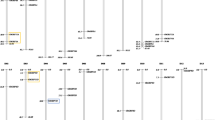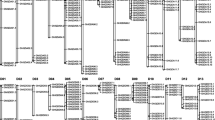Abstract
Background
As the world’s leading fiber crop and a major oil-producing crop, cotton fiber yield and fiber quality are affected by environmental stresses, especially heat, drought and salinity. The LAZ1 (Lazarus 1) family genes are responsive to abscisic acid, drought, and salt treatments. Currently, mining and functional analyses of LAZ1 family genes in cotton have not been reported.
Methods and results
In this study, 20 GhLAZ1 genes, designated GhLAZ1-1 - GhLAZ1-20, were identified in the genome of Gossypium hirsutum through the construction of an HMM model, and their molecular properties, chromosomal localization, phylogeny, gene structure, evolutionary selection pressure, promoter cis elements and gene expression under salt stress were analyzed. With the exception of GhLAZ1-17 and GhLAZ1-20, the remaining 18 GhLAZ1 genes were unevenly localized on 13 chromosomes in G. hirsutum; evolutionary analysis showed that these genes could be divided into three subfamilies; and evolutionary selection pressure analysis demonstrated that the GhLAZ1 genes were all under purifying selection. Many elements related to light responses, hormone responses, and abiotic stresses were predicted on the GhLAZ1 family gene promoters, and real-time quantitative PCR results showed that GhLAZ1-2, GhLAZ1-8, and GhLAZ1-18 were upregulated significantly in salt-treated cotton leaves.
Conclusions
Our results suggested that GhLAZ1 genes were involved in the salt tolerance mechanism in G. hirsutum and provided a reference for further exploring the function and molecular mechanism of LAZ1 genes.





Similar content being viewed by others
Data Availability
The genome information files and annotation files of G. hirsutum were downloaded from the NCBI database (https://www.ncbi.nlm.nih.gov/).
References
Dawson PA, Hubbert M, Haywood J, Craddock AL, Zerangue N, Christian WV, Ballatori N (2005) The heteromeric organic solute transporter α-β, Ostα-Ostβ, is an ileal basolateral bile acid transporter. J Biol Chem 280:6960–6968. https://doi.org/10.1074/jbc.M412752200
Liu BL, Yu HQ, Wen Q, Fu FL, Li WC (2019) Genome-wide analysis of LAZ1 gene family from maize. J Plant Growth Regul 39:656–668. https://doi.org/10.1007/s00344-019-10008-z
Liu Q, Vain T, Viotti C, Doyle SM, Tarkowská D, Novák O, Zipfel C, Sitbon F, Robert S, Hofius D (2018) Vacuole integrity maintained by DUF300 proteins is required for brassinosteroid signaling regulation. Mol Plant 11:553–567. https://doi.org/10.1016/j.molp.2017.12.015
Dawson PA, Hubbert ML, Rao A (2010) Getting the mOST from OST: role of organic solute transporter, OSTα-OSTβ, in bile acid and steroid metabolism. BBA-Mol Cell Biol L 1801(9):994–1004. https://doi.org/10.1016/j.bbalip.2010.06.002
Malinovsky FG, Brodersen P, Fiil BK, McKinney LV, Thorgrimsen S, Beck M, Nielsen HB, Pietra S, Zipfel C, Robatzek S, Petersen M, Hofius D, Mundy J (2010) Lazarus1, a DUF300 protein, contributes to programmed cell death associated with Arabidopsis acd11 and the hypersensitive response. PLoS ONE 5:e12586. https://doi.org/10.1371/journal.pone.0012586
Yang X, Zhang B (2021) Identification of the LAZ1 gene family and functional study of GmLAZ1 genes in soybean. Acta Agriculturae Zhejiangensis 33: 586–594. https://kns.cnki.net/kcms/detail/detail.aspx?FileName=ZJNB202104004&DbName=CJFQ2021
Naeem M, Iqbal M, Ul-Allah S, Chaudhary HJ, Nazeer W, Ashraf J, Baloch FS (2021) Expression studies of stress responsive genes in cotton Gossypium hirsutum L. Mol Biol Rep 48:7077–7085. https://doi.org/10.1007/s11033-021-06696-0
Zörb C, Geilfus CM, Dietz KJ (2019) Salinity and crop yield. Plant Biol 21:31–38. https://doi.org/10.1111/plb.12884
Li F, Gong M, Li C, Zhang YB (2019) Mining for functional genes of salt tolerant plants for drought resistance and their application to cotton breeding. Mol Plant Breed 17:7395–7400. https://doi.org/10.13271/j.mpb.017.007395
Ahanger M, Akram NA, Ashraf M, Alyemeni MN, Wijaya L, Ahmad P (2017) Plant responses to environmental stresses-from gene to biotechnology. AOB Plants 9(4):plx025. https://doi.org/10.1093/aobpla/plx025
Xie F, Wang Q, Sun R, Zhang B (2015) Deep sequencing reveals important roles of microRNAs in response to drought and salinity stress in cotton. J Exp Bot 66:789–804. https://doi.org/10.1093/jxb/eru437
Liu S, Zhang C, Zhu Q, Guo F, Chai R, Wang M, Deng X, Dong T, Meng X, Zhu M (2022) Genome- and transcriptome-wide systematic characterization of bZIP transcription factor family identifies promising members involved in abiotic stress response in sweet potato. Sci Hortic-Amesterdam, 303: 111185. https://www.nstl.gov.cn/paper_detail.html?id=5f8ce2208b68ea2b9c029118e95919c2
Zhao Y, Liang J, Wang Z, Yan T, Yan X, Wei W, Le M, Sun J (2023) Genome-wide identification and expression analysis of the trihelix transcription factor family in sesame (Sesamum indicum L.) under abiotic stress. Mol Biol Rep. https://doi.org/10.1007/s11033-023-08640-w
Finn RD, Coggill P, Eberhardt RY, Eddy SR, Mistry J, Mitchell AL, Potter SC, Punta M, Qureshi M, Sangrador-Vegas A, Salazar GA, Tate J, Bateman A (2016) The pfam protein families database: towards a more sustainable future. Nucleic Acids Res 44:D279–D285. https://doi.org/10.1093/nar/gkv1344
Marchler-Bauer A, Bo Y, Han L, He J, Lanczycki CJ, Lu S, Chitsaz F, Derbyshire MK, Geer RC, Gonzales NR, Gwadz M, Hurwitz DI, Lu F, Marchler GH, Song JS, Thanki N, Wang Z, Yamashita RA, Zhang D, Zheng C, Geer LY, Bryant SH (2017) CDD/SPARCLE: functional classification of proteins via subfamily domain architectures. Nucleic Acids Res 45:D200–D203. https://doi.org/10.1093/nar/gkw1129
Letunic I, Khedkar S, Bork P (2021) SMART: recent updates, new developments and status in 2020. Nucleic Acids Res 49:D458–D460. https://doi.org/10.1093/nar/gkaa937
Horton P, Park KJ, Obayashi T, Fujita N, Harada H, Adams-Collier CJ, Nakai K (2007) WoLF PSORT: protein localization predictor. Nucleic Acids Res 35:W585–W587. https://doi.org/10.1093/nar/gkm259
Voorrips RE (2002) MapChart: software for the graphical presentation of linkage maps and QTLs. J Hered 93(1):77–78. https://doi.org/10.1093/jhered/93.1.77
Kumar S, Stecher G, Tamura K (2016) MEGA7: molecular evolutionary Genetics analysis version 7.0 for bigger datasets. Mol Biol Evol 33(7):1870–1874. https://doi.org/10.1093/molbev/msw054
Chen C, Chen H, Zhang Y, Thomas HR, Frank MH, He Y, Xia R (2020) TBtools: an integrative toolkit developed for interactive analyses of big biological data. Mol Plant 13:1194–1202. https://doi.org/10.1016/j.molp.2020.06.009
Lescot M, Déhais P, Thijs G, Marchal K, Moreau Y, Van de Peer Y, Rouzé P, Rombauts S (2002) PlantCARE, a database of plant cis-acting regulatory elements and a portal to tools for in silico analysis of promoter sequences. Nucleic Acids Res 30(1):325–327. https://doi.org/10.1093/nar/30.1.325
Xiong E, Zheng C, Wang W (2016) Protein subcellular location: the gap between prediction and experimentation. Plant Mol Biol Rep 34:52–61. https://doi.org/10.1007/s11105-015-0898-2
Chakma SP, Chileshe SM, Thomas R, Krishna P (2021) Cotton seed priming with brassinosteroid promotes germination and seedling growth. Agronomy 11(3):566. https://doi.org/10.3390/agronomy11030566
Liu B, Wang X, Li K, Cai Z (2021) Spatially resolved metabolomics and lipidomics reveal salinity and drought-tolerant mechanisms of cottonseeds. J Agric Food Chem 69(28):8028–8037. https://doi.org/10.1021/acs.jafc.1c01598
Chen L, Liu L, Lu B, Ma T, Jiang D, Li J, Zhang K, Sun H, Zhang Y, Bai Z, Li C (2020) Exogenous melatonin promotes seed germination and osmotic regulation under salt stress in cotton (Gossypium hirsutum L). PLoS ONE 15:e0228241. https://doi.org/10.1371/journal.pone.0228241
Funding
This work was supported by the National Key R&D Program of China (2021YFE0101200), the PSF/CRP/18th Protocol (07), the National Natural Science Foundation of China (52161145104), and Key Research and Development Project of Jiangsu Province, China (Modern Agriculture, BE2022364).
Author information
Authors and Affiliations
Contributions
statement BW and YC conceived the idea and designed the experiment. TD, WW, YT, WF, DL, and KS performed the experiment. TD, ZP, and AD analyzed the data. TD wrote the manuscript. BW, YC, and MKRK revised the manuscript. All the authors have read and approved the final draft.
Corresponding authors
Ethics declarations
Conflict of interest
The authors declare no financial or non-financial conflict of interest.
Ethical Standards The experiments conducted in this study comply with the current laws of China.
Additional information
Publisher’s Note
Springer Nature remains neutral with regard to jurisdictional claims in published maps and institutional affiliations.
Rights and permissions
Springer Nature or its licensor (e.g. a society or other partner) holds exclusive rights to this article under a publishing agreement with the author(s) or other rightsholder(s); author self-archiving of the accepted manuscript version of this article is solely governed by the terms of such publishing agreement and applicable law.
About this article
Cite this article
Deng, T., Pan, Z., Wang, W. et al. Genome-wide analysis of the LAZ1 gene family in Gossypium hirsutum. Mol Biol Rep 50, 9273–9282 (2023). https://doi.org/10.1007/s11033-023-08788-5
Received:
Accepted:
Published:
Issue Date:
DOI: https://doi.org/10.1007/s11033-023-08788-5




